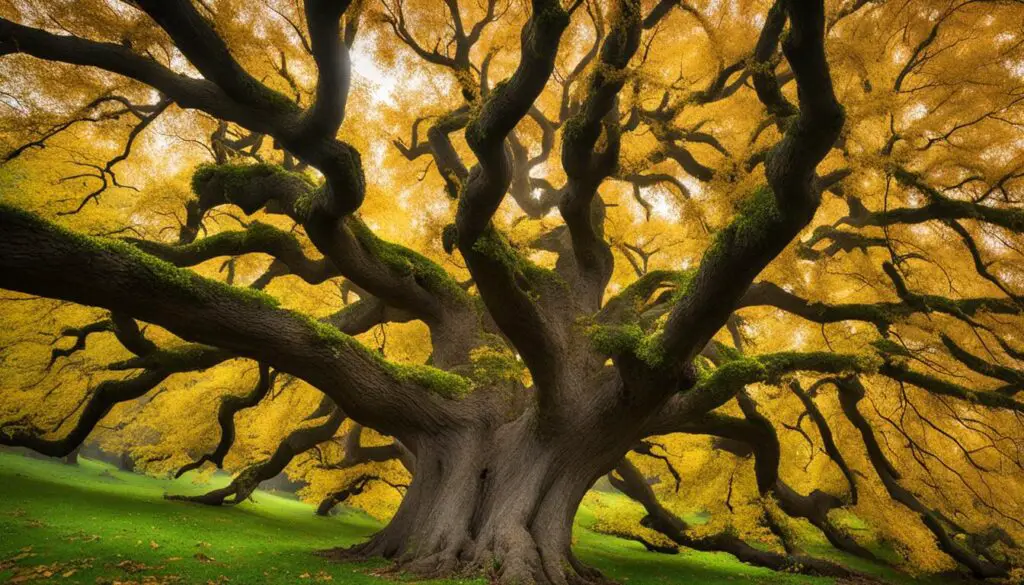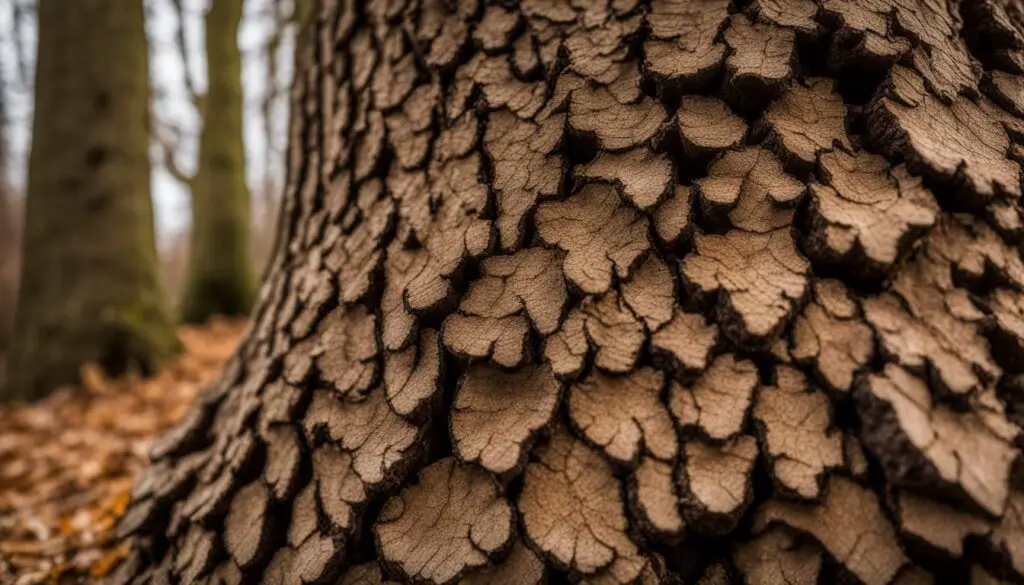Oak trees are known for their majestic beauty and breathtaking fall foliage. But have you ever wondered when exactly do oak trees lose their leaves? Understanding the timing of oak tree leaf drop can help homeowners and arborists better care for these magnificent trees throughout the year.
Most oak trees go through a natural cycle of shedding leaves as part of their life cycle. This process is influenced by genetics and environmental factors. While the majority of oak trees lose their leaves in the fall, some varieties may shed their leaves in the spring.
Key Takeaways:
- Oak trees shed their leaves as part of their natural life cycle.
- The timing of oak tree leaf drop can vary, with most trees shedding their leaves in the fall.
- Some oak tree varieties may shed their leaves in the spring.
- The shedding of leaves allows oak trees to conserve energy and resources during dormant periods.
- Monitoring oak tree health and providing necessary care can help maintain their vitality.
Why Do Trees Lose Their Leaves at All?
Trees undergo a fascinating process of shedding their leaves as part of their natural life cycle. This phenomenon occurs as trees enter a period of dormancy in preparation for winter. The timing of leaf drop is triggered by a combination of environmental cues, including a decrease in daylight hours and a drop in temperature. During this dormancy period, trees produce a substance called abscisic acid, which plays a critical role in leaf fall.
Abscisic acid is a hormone that causes the cells at the base of each leaf to weaken. As a result, the connection between the leaf and the tree gradually breaks down. This process, known as abscission, allows the leaves to detach and fall off, ultimately serving as a mechanism for trees to conserve energy and resources during the winter months.
Understanding Tree Dormancy
Dormancy is a crucial survival strategy employed by trees. It helps them adapt to changing environmental conditions by conserving energy and protecting themselves from potential damage caused by cold temperatures and frost. During dormancy, trees minimize their energy expenditure by shedding leaves, reducing metabolic activity, and redirecting resources to vital organs such as roots.
Did You Know? Abscisic acid is not solely responsible for leaf drop. Other factors, such as the production of ethylene gas and changes in water balance within the tree, also contribute to the process.
Leaf fall also assists trees in preventing dehydration during the colder months. By shedding their leaves, trees reduce surface area and limit water loss through transpiration. This allows them to conserve water and prevent freezing, providing a crucial survival advantage during winter.
Why Do Some Oak Trees Lose Their Leaves in the Spring?
While most oak trees shed their leaves in the fall as part of their natural life cycle, some varieties have a genetic predisposition to lose their leaves in the spring. This phenomenon is more common in certain regions like Europe and Asia. In addition to genetics, environmental factors can also influence this spring leaf shedding. Prolonged drought or disease infestation can cause oak trees to shed their leaves earlier than usual, leading to yellowing or browning of the foliage before it eventually falls off.
Genetics plays a significant role in determining when oak trees shed their leaves. Some oak species have inherited traits that cause them to drop their leaves in the spring instead of the typical fall season. These genetic differences can vary among different oak populations and regions, resulting in diverse leaf-shedding patterns.
However, it’s not just genetics that affect spring leaf shedding in oak trees. Environmental factors also play a crucial role in determining when this process occurs. Prolonged drought can stress the trees, causing them to lose their leaves prematurely to conserve energy and resources. Similarly, diseases and infestations from pests can weaken the trees, leading to the shedding of leaves as a defensive mechanism.
During spring leaf shedding, oak trees may exhibit symptoms such as yellowing or browning of the leaves. This discoloration is often a result of the tree’s response to environmental stressors. As the trees undergo stress, the chlorophyll in the leaves breaks down, revealing other pigments, causing the foliage to change color before dropping off.

Which Trees Lose Their Leaves in Spring?
When it comes to oak trees, most individuals associate them with the vibrant colors of the fall foliage. However, there are certain species of oak trees that shed their leaves in the spring, rather than the traditional autumn season. Live oaks and water oaks are two examples of oak trees that exhibit this unique characteristic.
Live oaks, scientifically known as Quercus virginiana, are tardily deciduous trees that are commonly found in coastal areas of the southeastern United States. Despite shedding all their leaves annually, live oaks undergo this process in the spring, making them distinct from their counterparts that shed leaves in the fall.
Water oaks, scientifically known as Quercus nigra, are another species of tardily deciduous oak trees. Like live oaks, water oaks shed their leaves in the spring, contributing to the cycle of leaf growth and renewal.
It is important to note that even though live oaks and water oaks shed their leaves in the spring, they are still considered deciduous trees. This classification is based on their ability to go through a full leaf cycle every year, even though their shedding occurs at a different time than other deciduous trees.
Comparison of Oak Tree Leaf Shedding
| Tree Species | Leaf Shedding Season |
|---|---|
| Live Oak (Quercus virginiana) | Spring |
| Water Oak (Quercus nigra) | Spring |
| Other Oak Species | Fall |
The unique leaf-shedding behavior of these tardily deciduous oak trees adds to the diversity and wonder of nature’s cycle. By shedding their leaves in the spring, live oaks and water oaks bring forth fresh growth and contribute to the overall beauty of the landscape.
Environmental Factors Affecting Oak Tree Leaf Drop
Oak trees are susceptible to various environmental stressors that can impact their leaf health and lead to leaf drop. These stressors include prolonged drought, disease infestation, and insect pests.
During periods of drought, oak trees may experience water scarcity, causing the leaves to wilt and turn yellow or brown. This is a protective mechanism, as the tree conserves water and redirects it to essential parts of the tree, such as the roots and trunk.
Disease infestation is another environmental stressor that can affect oak trees’ leaf health. Fungal or bacterial diseases, such as oak wilt or powdery mildew, can cause leaf discoloration, lesions, or premature defoliation. These diseases weaken the tree’s defense mechanisms, making it more susceptible to other stressors.
Insect pests can also contribute to leaf drop in oak trees. Certain insects, such as caterpillars and beetles, feed on oak tree leaves, causing damage and triggering leaf drop. For example, the larvae of oak leaf-feeding caterpillars can defoliate entire branches, leading to significant foliage loss.
Monitoring oak trees for signs of distress is crucial in identifying and addressing these environmental stressors. By paying attention to changes in leaf color, wilting, or signs of pest infestation, arborists and homeowners can take proactive measures to protect oak trees.
Image alt tag: oak tree leaf drop

Common Environmental Stressors and their Effects on Oak Tree Leaf Health
| Environmental Stressor | Effects on Leaf Health |
|---|---|
| Prolonged Drought | – Yellowing or browning of leaves – Wilting and leaf drop |
| Disease Infestation | – Leaf discoloration and lesions – Premature leaf drop |
| Insect Pests | – Leaf damage, including holes or skeletonization – Defoliation and leaf drop |
Environmental stressors such as drought, disease infestation, and insect pests can significantly impact oak tree leaf health and lead to leaf drop. By monitoring for signs of distress and taking proactive measures to address these stressors, we can help preserve the beauty and vitality of oak trees.
The Life Cycle of Oak Trees
Oak trees have a fascinating life cycle that consists of various stages, including dormancy, leaf growth, and acorn production. Understanding this cycle can help us appreciate the natural processes that these majestic trees undergo throughout the year.
Dormancy:
As the days become shorter and the temperature drops in the fall, oak trees enter a state of dormancy. This period is characterized by a slowing down of metabolic processes in the tree. One of the prominent signs of dormancy is the shedding of leaves. By conserving energy during the winter months, oak trees are better equipped to survive the cold and harsh conditions.
Leaf Growth:
In the spring, as the days become longer and the temperature starts to rise, oak trees come out of dormancy and begin to grow new leaves. This growth is a result of the tree’s metabolic processes kicking back into gear and the availability of resources, such as water and sunlight. The new leaves provide the tree with the necessary tools for photosynthesis, allowing it to produce food and continue its life cycle.
Acorn Production:
One of the most iconic aspects of oak trees is their ability to produce acorns. Acorns serve as the tree’s reproductive structures, containing the seeds that eventually develop into new oak trees. Acorn production typically occurs in the late spring and early summer. The process begins with the development of flowers, followed by pollination and fertilization. The fertilized flowers then transform into acorns, which will eventually fall from the tree and create the next generation of oak trees.
By going through the cycle of dormancy, leaf growth, and acorn production, oak trees ensure the continuity of their species and play a vital role in maintaining the balance of ecosystems they inhabit.
Survival Strategies for Oak Trees in Winter
Oak trees have developed ingenious strategies to survive the harsh conditions of winter. These strategies enable them to endure freezing temperatures and limited resources, ensuring their long-term survival.
One of the key survival strategies of oak trees is their bark insulation. The thick bark acts as a protective layer, shielding the internal tissues from extreme cold. It acts as a barrier, preventing the freezing temperatures from reaching the vital parts of the tree and causing damage.

To further protect themselves from the freezing temperatures, oak trees undergo a process of dehydration. As winter approaches, oaks withdraw fluid from their cells, reducing the water content. This dehydration prevents the liquids inside the tree from freezing and causing structural damage.
The remaining fluid in the tree has a higher concentration of sugars, acting as a natural antifreeze. This high sugar content lowers the freezing point of the fluid, allowing the tree to resist damage from freezing temperatures more effectively.
Additionally, oak trees strategically store most of their nutrients in their roots during the winter months. By keeping valuable resources in their root system, they ensure that vital energy reserves are protected and readily available for spring growth.
These survival strategies of bark insulation, dehydration, and resource storage enable oak trees to endure the challenging conditions of winter and emerge healthy and resilient when warmer temperatures return.
Spring Growth and Pollination
In the spring, oak trees undergo a period of rapid growth, marked by the emergence of leaf buds and the development of catkins, which are the male flowers of the tree. This phase of growth and pollination is crucial for the continuation of the oak tree’s life cycle.
The emergence of leaf buds indicates the onset of new growth for the oak tree. These buds contain the potential for new leaves to unfurl and contribute to the tree’s vibrant canopy. As the days become longer and temperatures rise, the energy stored in the tree’s roots fuels the production of new leaves.
Simultaneously, catkins, also known as aments, emerge on the oak tree. These elongated structures are composed of tightly clustered, tiny flowers that release pollen grains. The catkins, hanging from the branches, sway in the breeze, ensuring the dispersal of pollen.
The wind plays a critical role in the pollination of oak trees. As the wind carries the pollen grains from the catkins, some of it reaches the female flowers, known as pistillate flowers, present on the same or neighboring trees. The pollen fertilizes the female flowers, initiating the process of acorn production.
The Pollination Process in Oak Trees
| Pollen Dispersal Mechanism | Acorn Production |
|---|---|
| Pollen grains released from the catkins of male flowers | Female flowers are fertilized by the pollen grains |
| Wind disperses pollen grains to other oak trees | Female flowers develop into acorns |
| Pollen grains land on the stigma of female flowers | Acorns mature over the course of several months |
The successful fertilization of the female flowers leads to the development of acorns. Acorns, the seeds of the oak tree, play a vital role in the reproduction and propagation of oak tree populations. They contain all the necessary nutrients for the growth of a new oak tree, ensuring the continuation of the species.
Overall, the spring growth and pollination processes in oak trees are essential for the tree’s yearly life cycle. The emergence of leaf buds and the development of catkins mark the beginning of new growth, while the dispersal of pollen and subsequent acorn production contribute to the tree’s reproductive success.
Interactions with Insects
Oak trees have a fascinating relationship with various insects throughout their life cycle. These interactions play a crucial role in the ecosystem and can have a significant impact on the health and well-being of the trees.
One example of insect interactions with oak trees is the presence of winter moth larvae. These tiny caterpillars feed on young oak leaves, posing a threat to the tree’s foliage. In response, oak trees have developed a defense mechanism. They produce chemicals that hinder the growth of the winter moth larvae, safeguarding their leaves from complete consumption.
Gall wasps are another type of insect that interacts with oak trees. These wasps lay their eggs in the female flowers of the oak tree, triggering the formation of galls. Galls are abnormal growths in the tree’s tissues, serving as protective homes for the developing gall wasp offspring. While galls may affect the appearance of the tree, they generally do not cause severe harm to the overall health of the oak.
These interactions between insects and oak trees highlight the intricate dynamics within the ecosystem. While some insects may pose challenges to the tree’s well-being, others, like gall wasps, have co-evolved with oak trees and have a mutually beneficial relationship. Understanding these interactions can help arborists and nature enthusiasts appreciate the delicate balance of nature and implement appropriate measures for oak tree care and conservation.
Historical Uses of Oak Trees
Oak trees have played a significant role in history, serving various purposes that highlight the versatility and durability of their wood. One of the most notable uses of oak trees was as a building material, where their strong and resilient wood was highly valued.
Shipbuilders particularly favored oak trees for constructing ships due to their strength and ability to withstand the harsh marine environment. The importance of oak in shipbuilding is exemplified by the construction of the HMS Victory, a renowned British warship that played a crucial role in historical naval battles. Thousands of oak trees were used in the construction of this iconic vessel, showcasing the reliance placed on oak for its exceptional durability.
To meet the demand for timber for warships, oak trees were extensively planted in Britain. This proactive approach ensured a steady supply of oak wood for shipbuilding, contributing to the strength and might of the navy’s warships. The planting of oak trees for this specific purpose highlights the strategic significance placed on oak and its role in naval power.
Aside from ship construction, oak wood was utilized in various other building projects, from grand architectural structures to everyday items. The remarkable strength and longevity of oak made it a preferred choice for beams, flooring, furniture, and even barrels used for aging wine and spirits.
| Historical Uses of Oak Trees |
|---|
| Shipbuilding |
| Building construction |
| Furniture making |
| Barrel production |

The Importance of Monitoring Oak Trees
Proactively monitoring the health of oak trees is essential to ensure their long-term vitality and environmental contribution. By regularly assessing the signs of distress and implementing appropriate conservation measures, we can protect these majestic trees from potential threats and preserve their natural beauty.
Oak tree health can be monitored by observing indicators such as yellowing or browning leaves, which may signify underlying issues or stressors. Early detection of irregularities allows for timely intervention and prevention of further damage.
Conservation measures play a significant role in safeguarding oak tree health. Providing adequate watering during drought periods helps maintain tree hydration, fortifying their resistance against stress. Additionally, addressing diseases and pests promptly prevents their spread and limits potential damage that can compromise the tree’s well-being.
By prioritizing the monitoring of oak tree health and employing appropriate conservation measures, we promote sustainable environmental practices and ensure the longevity of these vital tree species.
Conclusion
Oak trees go through a unique leaf cycle that involves seasonal shedding as part of their natural life cycle. While most oak trees lose their leaves in the fall, there are certain species that shed their leaves in the spring. The timing of leaf drop in oak trees is influenced by both genetic factors and environmental conditions.
Understanding the oak tree leaf cycle is crucial for homeowners and arborists who want to properly care for these magnificent trees. By knowing when to expect leaf shedding, they can anticipate the tree’s dormancy period and provide appropriate maintenance. Monitoring environmental factors such as drought or disease infestation is also important to ensure the health and vitality of oak trees.
From their distinct leaf shedding to the growth of new leaves and production of acorns, oak trees have a fascinating life cycle. By appreciating and respecting these natural processes, we can continue to enjoy the beauty and benefits that oak trees bring to our environment.
FAQ
When do oak trees lose their leaves?
Oak trees typically shed their leaves in the fall as part of their natural life cycle. However, some oak tree varieties may shed their leaves in the spring.
Why do trees lose their leaves at all?
Trees lose their leaves as part of their natural dormancy process, which prepares them for winter. During this period, the trees produce a substance called abscisic acid, which triggers and facilitates leaf fall.
Why do some oak trees lose their leaves in the spring?
Some oak trees have a genetic predisposition to shed their leaves in the spring. Additionally, environmental factors like drought or disease infestation can also cause spring leaf shedding.
Which trees lose their leaves in spring?
Live oaks and water oaks are examples of oak trees that shed their leaves in the spring, making them “tardily deciduous.”
What are the environmental factors affecting oak tree leaf drop?
Environmental stressors like prolonged drought, disease infestation, and insect pests can cause oak trees to shed their leaves to conserve energy and resources.
What is the life cycle of oak trees?
Oak trees go through a yearly life cycle that includes dormancy, leaf growth, and acorn production. They shed their leaves in the fall, start new growth in the spring, and produce acorns for the continuation of their life cycle.
What survival strategies do oak trees have in winter?
Oak trees have bark insulation, dehydrate themselves to prevent freezing, and store nutrients in their roots during winter to survive harsh conditions.
What happens during spring growth and pollination?
In the spring, oak trees experience rapid growth with the emergence of leaf buds and the development of catkins, which release pollen grains to fertilize the female flowers and produce acorns.
How do oak trees interact with insects?
Oak trees interact with insects such as winter moth larvae, which the tree defends against, and gall wasps, which lay their eggs in the female flowers, leading to the formation of galls.
What were the historical uses of oak trees?
Oak trees have been historically used as a building material, particularly in shipbuilding. They were extensively planted in Britain to meet the demand for timber for warships for the navy.
Why is it important to monitor oak trees?
It is important to monitor oak trees for signs of distress, such as leaf discoloration, disease infestation, or insect pests. Taking proactive conservation measures can help protect oak trees from environmental stressors and maintain their health.
What is the conclusion about oak tree leaf cycle and seasonal shedding?
Oak trees have a distinct leaf cycle, with most shedding their leaves in the fall. However, some varieties may shed their leaves in the spring. Understanding the timing and factors influencing leaf drop can help in caring for oak trees throughout the year.

